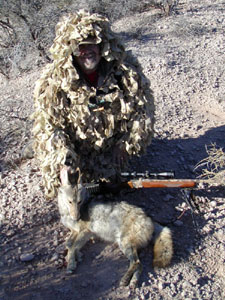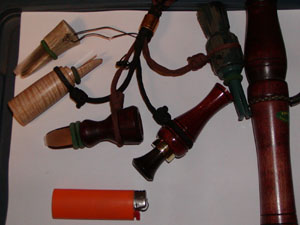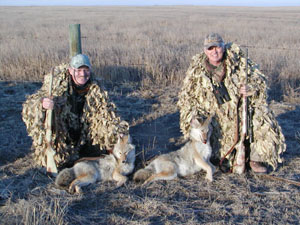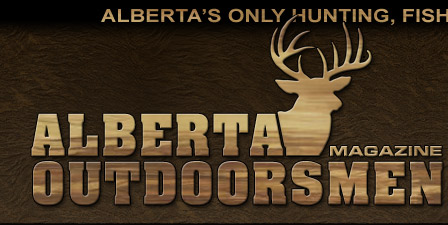|
There seems to be a fair amount of interest in calling coyotes. I've put together some info that may help. It's a little long, but may save you some time in the field.
INTRODUCTION TO CALLING COYOTES
There comes a time in the life of the outdoor enthusiast when he must make a decision. That time is in December each year. Hunting season is winding down and ice-fishing hasn't started yet. Should I tackle my "Honey Do" list, do some early Christmas shopping or go hunt the wiliest animal on the planet? Gee! That's a toughie.
Canis Latrans, the coyote, the most adaptable animal in North America. You can find him at seaside, in the desert, in the forest, and in the city or on the bald prairie at forty below. He will kill anything he is able. He will eat almost anything he can find whether animal or vegetable. His sense of smell, hearing and eyesight are better than excellent. Put this together with his social structure and his skill as a hunter (he does it 24/7 for a living) and you have a challenge ahead of you.
 |
| There are many options available as to what type of firearm can be used when coyote hunting. - photo Jim Renaud |
Fortunately predator hunting doesn't require a person to get a second mortgage to buy a bunch of specialized equipment. Depending on the type of terrain, a hunter can use a shotgun with 00 buck or 4 buck, or any center fire rifle. The shotgun is effective up to 40 yards, and believe me, when coyotes come inside that range, things happen in a hurry. Any caliber used for deer will certainly be sufficient to take coyotes. If saving the pelt is a concern, the smaller .22 caliber center fires such as .204, .220 Swift, .222, .223, .22-250 or .243 would be a good choice. The .17 Rem center fire is also very popular inside the 200 yard range.
As for optics, a fixed 4 or 6 power scope would certainly work, and a variable 3x to 9x may be better. I personally do not see the need for anything more than 9 power and most of the time my scope is on 5x or 6x. The binoculars that are used for other types of hunting should be put into service for coyotes. I use them every time I set up, even in heavier cover. If you plan to shoot the long shots, a rangefinder would come in handy. Most of us are not as accurate at judging distance as we think we are, especially in the wide open spaces.
 |
| Camo clothing is very important as even the slightest movement can be detected by the wily coyote. - photo Jim Renaud |
More important than firearm choice or optics, is the ability to shoot accurately. This means you must be completely comfortable with your firearm and it means practice before you get into the field. If you are going to take the 200 yard-plus shot, you had better be able to hit a 4 inch circle all day long at that distance on the range. It is much harder in the field with 2 or 3 coyotes coming in on the run. Too often we spend hours and hours preparing equipment and traveling and less than 30 minutes a year shooting our rifle. I wonder why we miss? I also like to use a bipod or shooting sticks.
Camo clothing is important, but almost any pattern will get you started. You may want to be more specific after you have been out a few times. Snow cover simplifies things as any white coveralls would work. Even a white bed sheet would get you by in a pinch. Since you will be sitting for extended periods, it is critical that you have clothing that is comfortable.
The one piece of specialized equipment required for this type of hunting is a call. Some areas allow the use of electronic calls, while in other jurisdictions they are illegal. Check your local regulations before you invest in calls. I prefer to use hand calls as they give me more options in a given situation. Most of the calls mimic some poor wee beasty in extreme danger or distress. There are calls that imitate any animal from rabbits and birds, to feral hogs or livestock. Mr. Coyote is not particular as long as it sounds like an easy meal.
The easiest and least expensive calls to get are closed reed calls. These are very similar to calls used for ducks and geese. They are fairly easy to master, but have a tendency to freeze up in colder temperatures. Open reed calls require a little more practice, but freeze up is not a problem and a hunter can produce a wider range of sounds. Once you have mastered the distress call, you may want to include a howler in your bag of tricks. A good howler allows you to have some interesting conversations with old wily.
 |
| Calls are the one piece of specialized equipment you will need when coyote hunting. - photo Jim Renaud |
Other than your favorite skinning knife, a short piece of rope to transport your coyote and a fanny or back pack to put you gear in, I think we're ready to go. No drive by shootings now, that only shows you may be luckier than the coyote. Let's see if you're smarter.
It seems like such a simple thing, but if you are to have success you must call where there are coyotes. If you are hunting on public land, you will have to do some scouting. Maybe you've seen coyotes in areas that you hunt for other game. If not, look for sign, dens, scat or howling at night. If you are hunting private property, it makes your job a lot easier, because when you go to ask permission for access, you will have an opportunity to ask the landowner about the coyote population in the area. You don't have to pinpoint the coyote's position. We are going to call them in, right up close and personal, sometimes from as far as two miles away.
Having found an area that has coyotes, we now must decide on a stand location. Oh, we're not going to build or pack a stand, although in areas of thick bush some predator hunters use a ladder. No, we are going to try to hide the truck, not slam the doors, and proceed quickly and quietly to the spot we have decided to call from with as little disturbance as possible.
 |
| It is always a benefit to have a partner watch your back when coyote hunting. Coyotes can appear from any direction at any time. - photo Jim Renaud |
It is difficult to control movement and noise with more than 2 hunters. While a person can hunt successfully solo, it is a benefit to have a partner to watch your backdoor. It is common for coyotes to try to come in downwind. Once you reach your spot, get set up so you have a decent field of view and some shooting lanes. Coyotes can and do come in from any direction. If you are in heavy cover, begin calling softly as there may be a coyote having a siesta close by and we don't want to scare him out of the country. Wait a few minutes and then increase the volume. I have had coyotes come in on the run in as little as 90 seconds. I have also had them sneak in after 30 minutes, so you must expect the unexpected and be alert. Nothing gets the heart going like having no coyotes around, to having 3 or 4 suddenly appear on a dead run. If you have set up in the open prairie, you can watch them come a long ways. Sometimes they stop when they get close; sometimes they almost run you over. I usually call 15 to 20 minutes. If I don't see something by then, I move to another spot. I call anytime through the day from dawn to dusk. The only time I am sure to have no luck is sitting at home calling from the couch.
I've only focused on coyotes here, but the opportunity is there to call other predators in while calling coyotes. Fox and bobcat will also respond to distress calls. Bears and cougar can be called as well. When you think about hiding and pretending to be food for an animal that makes his living killing, or when you have a big male come in all bristled and snarling ready to defend his turf, that's entertainment my friend. Predator hunting is growing in popularity by leaps and bounds and it's easy to see why. The first time you call a predator in, up close and personal, you will definitely have a new pastime. Or… you could have a look at that "Honey Do" list.
|

